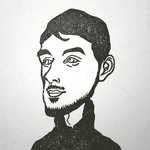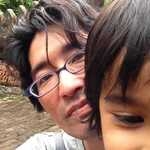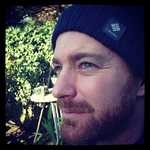The stapled packet explained the region in elegant robot-translation poetry:
Mountains upon mountains, deep and steep, since the times of ancient times, the Kii Mountain Range has been considered to be a special place where gods dwell.
Mountains upon mountains, indeed! The views were extraordinary from the cradle of that range — ridges rising all around, flocks of birds atop various sandy aits, small (but significant) rapids. To the credit of our boatman — Mr. Takahashi — he maneuvered through those rapids with a dexterity that, given his age, his infirmity, could only have been born from a fording genius or generational muscle memory. I pictured his great grandfather and great-great grandfathers navigating in the same way, carrying pilgrims safely to the next shrine. Since the times of ancient times …
This was the Kumano River. The plan was to ride in a cramped, wooden, flat-bottomed boat to Shingu City — situated ahead of where the river empties into the Pacific Ocean — just as the ancient pilgrims had done.
And so we did precisely that, wearing the very same hats they wore.
The most important shrine in Shingu is called Hayatama (速玉), or fast-balls, a curious name considering the main object of worship is a vaginal shaped pair of rocks — the Gotobikiiwa.
The six of us on the tour — the only six people riding the river that day — boarded the boat and Miss Murayama, our jubilant guide, welcomed us. She then pointed to a man in the back saying, “That’s Mr. Takahashi!”
He was a creature as ancient as the very path we were traversing, a man so old, stooped, and confused looking I thought for sure he was a part of a charity program for a local Day Service home. Assumed he was wearing white as to make rescue easier were he to fall into the swift waters. But, no, he was our boatman. “Our lives are in your hands, Mr. Takahashi!” the guide yelled, smiling, as those hands of his, shaking badly, pushed an oar into the bank and off we set, all of us on the tour sharing worried glances.
Guide us he did, that Mr. Takahashi, steely-eyed and toothless. Miss Murayama told us the names of every crag on every face of every mountain along the river. She told us that each was a god, or privy to a god, in proximity to a god or gods, the son or daughter of a god, the parent of a god. Who knew so much could be named or would want or need a name, or that so many gods would choose this place as their home; a tenement of granite for the otherwise shrineless.
She pointed to a large scar in the ridge, and told us its story — remnants from the blastings used to release rock for Kansai International Airport, an airport built atop clay in the middle of Osaka Bay, southwest of Osaka City proper. In total, three mountains were excavated for 21 million cubic meters of landfill. It looked like a giant had used a saw to suddenly and crudely chop the cliffs.
But what of those gods dwelling right there? Which gods may have been displaced by the blasts? And which named rocks were now lost beneath the tarmac, or, more importantly, which rocks, once invisible now made visible, were newly named?
We arrived at Shingu — the destination — some hour and a half after departing. Nobody died. The rapids were navigated. The scarred mountain mourned. The other mountains revered. The birds quietly considered. But mainly we sat in a daze, the lull of our small wooden boat atop water rocking us back and forth, Miss Murayama naming for us all the things that could and should be named.
The group mulled about the small port. Just then I remembered Mr. Takahashi. I turned to walk back and thank him, but he was already gone. A tiny white bundle, huddled at the stern, motoring upstream in the last of the day’s sunlight, having silently and wordlessly left us. I decided then and there that Mr. Takahashi was one of the many small gods of this peninsula. That he and his ilk were protectors since times of ancient times, within the valley of mountains upon mountains, deep and steep. And he knew well and good that our stone vagina was waiting and, clearly, wanted nothing to do with it.





















